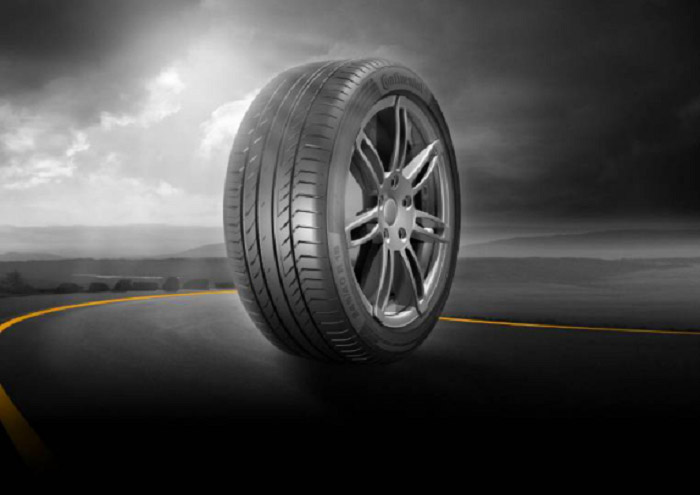
Shengtai Group’s automated sorting system of finished tires can directly improve work efficiency and slash operating cost for businesses through automated conveying, sorting, stacking, storing and shipping of finished tires as well as information tracing.
Project: Provide “Automated Sorting System of Finished Tires” for Shengtai Group
In 2015 Qingzhou Shengtai Rubber (hereinafter referred to as “Shengtai”) decided to start the automated sorting system of finished tires that will deliver 12 million sets of finished tires per year as a way to keep up with corporate development and market demand, raise production benefit and reduce cost. After the half-year readjustment and demonstration, Wuxi Zhongding Integration Technology Co., Ltd. (hereinafter referred to as “Zhongding Integration”) offered the all-in-one solution that can convey, store and sort finished tires for Shengtai and forged the partnership.
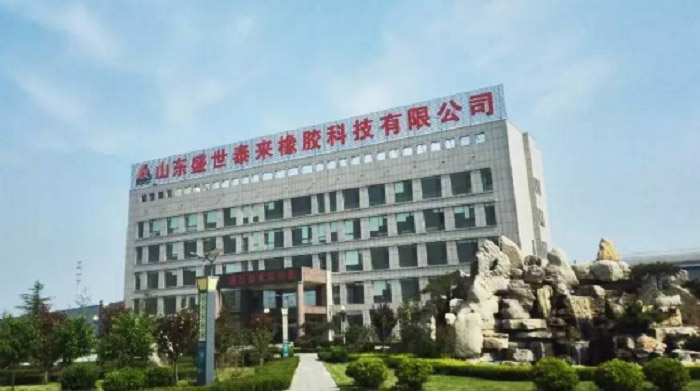
Shengtai Group
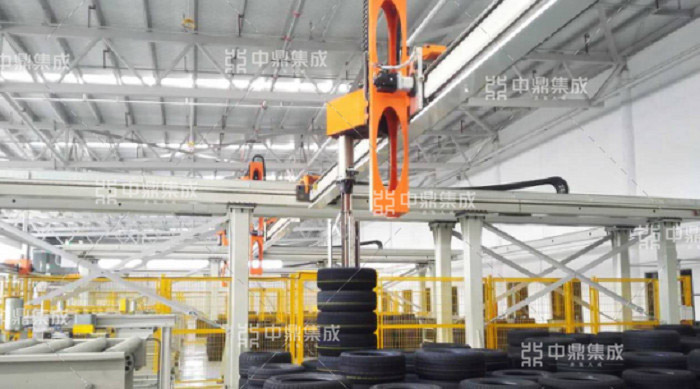
Automated Sorting System of Finished Tires
Smart Outbound and Inbound Processes with Automation and Intelligence
The automated three-dimensional sorting project covers around 21,000 square meters, with a total investment of about 200 million yuan. Shengtai automated sorting project contains automated conveying, intelligent sorting, automated stacking and inbound/outbound processes after finished products are detected by the dynamic balancing machine. The whole process is automated, intelligent and unmanned through ERP information system, which can meet the demand and development of 12 million sets of finished tires in the long term.
This scheme adopts the combined storage rack, including 14 lanes and 14 stackers over 30 meters in height. There are 50,400 pallet locations in total. This system can convey products to storage area via the automatic sorting system on the second floor. The panoramic scanning system automatically sorts out qualified products and defective goods. Then, the portal robot stacks products. Finally, products are sent to the entrance through conveyor line and stored in warehouse via 14 trolley stackers. On the floor has chain machine, roller conveyor, dismantling machine, telescopic belt machine, which can ship finished tires.
Overall Process Drawing
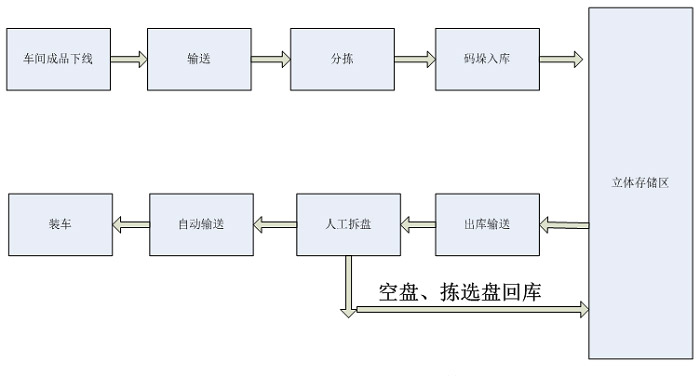
1. Inbound Process of Finished Products
The finished products are detected by the dynamic balancing machine. Qualified products will be sent to the second floor for sorting via corridor. Defective products will be repaired and then sent to the second floor for sorting via corridor once again.
The sorting area on the second floor will be divided into 12 sorting ports along the sorting line. The portal robot will automatically stack tires and move them to the designated place of the movable storage platform. If the storage platform is filled with a pile of single tires, the portal robot will move the whole pile of tires to the designated place for temporary storage. The portal robot will move a pile of tires on the corresponding stack position number to empty pallets according to WMS’s data instructions. The filled pallets will be sent to the designated entrance of master computer via RGV, and then moved to the designated storage location by stacker cranes.
A: Exception Handling in Sorting: the sorting machine is provided with an overflow outlet, which allows workers to handle and store finished tires in the exception handling location.
B: The whole pile shall accept appearance inspection and barcode review, which will be moved to the exception handling location for manual processing in case of exceptions before storage.
2. Outbound Process of Finished Products
Following WMS’s instructions, the stacker crane can take out corresponding pallet and put it on the conveyor, which will be sent to the shipment port through circular conveyor line. Finished tires will be shipped to truck through manual unstacking, labeling, belt conveyor, tire stand kit and telescopic belt conveyor. Finally, workers finish loading and shipment.
A: Empty pallet: Empty pallets will be automatically piled up for storage in the warehouse after workers unstack finished tires.
B: Sorting: The unstacked pallets will be automatically stored in the warehouse through circular conveyor line after workers unstack finished tires.
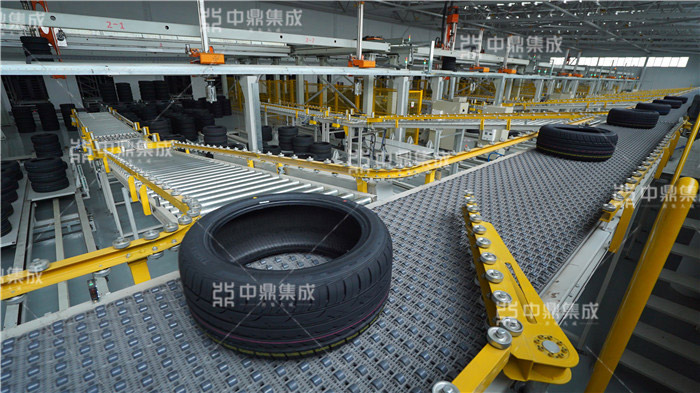
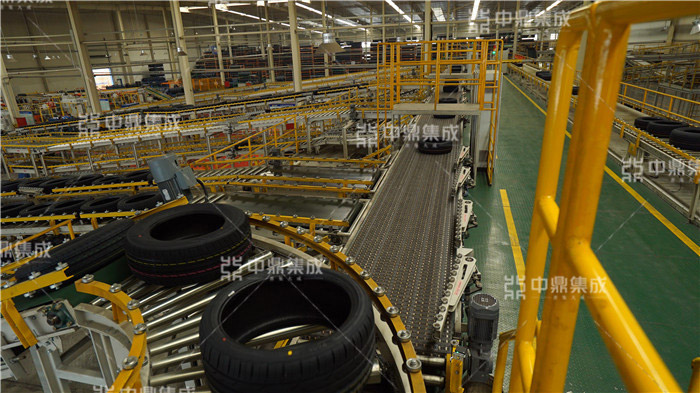
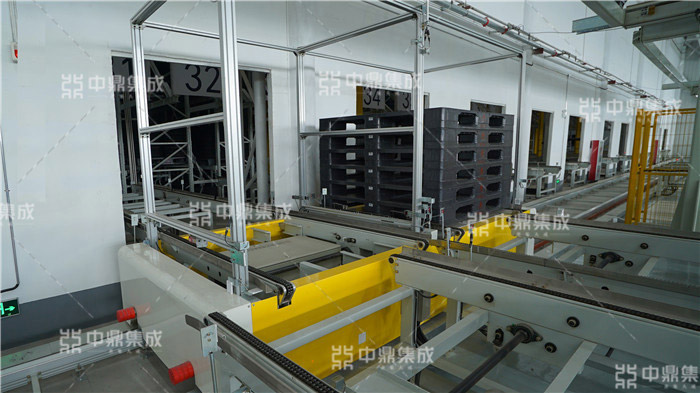
Rendering of Intelligent Warehouse Syste
Project Highlight
The whole system can prevent human error by tracking each finished tire and controlling inbound and outbound information, thus realizing information traceability, cutting operating cost and increasing work efficiency.
1. Application of Ultrahigh Stacker Cranes in Three-dimensional Warehouse:
The three-dimensional warehouse is generally less than 24 meters in height. In consideration of cost, stacker cranes made in China are hardly more than 24 meters in height. This solution adopts the fifth generation ultrahigh stacker cranes by Zhongding Integration, which expands storage capacity by 28% if the area remains unchanged.
2. Application of Portal Robot in Product Specifications:
In the course of inbound process, 1,660 tires of 220 product specifications need to be sorted and stacked in one hour. The partitioned operation of portal robots offers an efficient solution, which is eight to ten times as efficient as traditional sorting and stacking.